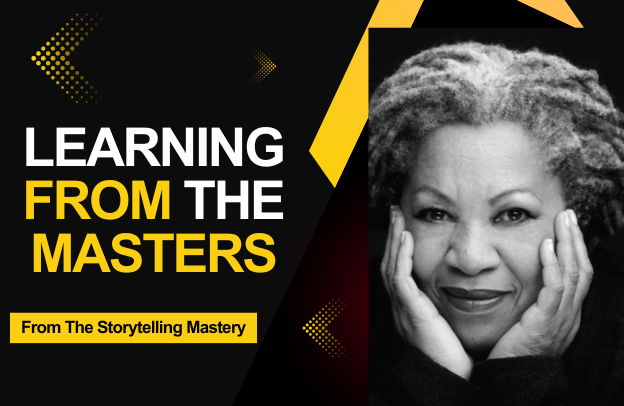7 Key Businesses Storytelling Strategies From Tony Robbins – Learning From The Masters

Tony Robbins is a renowned motivational speaker and life coach known for his powerful and engaging storytelling. While his expertise lies in personal development rather than business, many of his storytelling strategies can be adapted and applied to a business context. Start by downloading the first chapter of The Storytelling Mastery.
Who is Tony Robbins?
Tony Robbins is a renowned American author, entrepreneur, and motivational speaker, widely recognized for his influential work in the self-help and personal development industry.
Born on February 29, 1960, Robbins has built a successful career spanning several decades, during which he has impacted millions of lives through his dynamic seminars, bestselling books, and coaching programs. Robbins’ teachings often focus on strategies for achieving personal and professional success, emphasizing the importance of mindset, goal-setting, and taking massive action to create lasting positive change in one’s life.
See the full video – 7 Key Businesses Storytelling Strategies From Tony Robbins
With a charismatic and energetic speaking style, Robbins has become a household name and a sought-after speaker on topics such as peak performance, leadership, and financial success.
Beyond his motivational work, he has also been involved in philanthropy, contributing to causes such as education, hunger relief, and youth empowerment. Tony Robbins continues to be a prominent figure in the self-help industry, inspiring individuals worldwide to unleash their potential and live extraordinary lives.
Here are seven key storytelling strategies businesses can learn from Tony Robbins and I encourage you to pay attention to every one of them:
1. Emotional Engagement:
Learn to create a strong emotional connection with your audience. Share relatable and emotionally charged stories that resonate with your audience. For instance, Robbins often shares personal stories of overcoming challenges and connecting with his audience on a deeper emotional level.
In business storytelling, you can share anecdotes of triumphs, challenges, or customer experiences that evoke emotion and create a connection with your audience.
2. Clear Purpose and Message:
Have a clear purpose and message in your storytelling. Clearly define the purpose of your story and the message you want to convey. Tony Robbins is known for his clarity in delivering messages.
A few days ago, for example, I conducted our weekly LinkedIn audio live event on business storytelling and the topic was the return on investment for business storytelling. Now, you can imagine how much attention we paid to the clarity of message and storytelling KPI. You can never underestimate that.
My advice is to always ensure that your stories align with your brand message and convey a clear and focused takeaway for your audience. this will go a long way in helping you to get a good return in your business storytelling.
3. Use of Metaphors and Analogies:
Consider utilizing metaphors and analogies to simplify complex concepts. Robbins often uses metaphors and analogies to explain complex psychological concepts.
In business, make sure you employ metaphors to make your messages more accessible. For example, if your business is going through a transformation, use a metaphor to explain it, such as comparing it to the lifecycle of a butterfly.
That is just an example. you know your business better, so you know how to frame your situation.
4. Dynamic Delivery:
Deliver stories with energy and enthusiasm. Robbins is known for his dynamic and energetic delivery. Have you seen Tony Robbins speaking on stage or listening to his recordings on YouTube? There are hundreds if not thousands of his video clips everywhere. So, you have no problem getting this feeling from him.
In your business storytelling, learn to convey enthusiasm and passion to captivate your audience. Whether during presentations to clients, employees, or stakeholders, always infuse energy into your storytelling to maintain engagement and retention.
Of course, all these tips are exhaustively explained in my five-part Storytelling Mastery. If you haven’t read any of the books, this is the right time to pick a copy for yourself on Amazon or my website, Obehiewanfoh.com.
5. Incorporate Humor in your narratives:
Use humor to connect with your audience. Robbins often incorporates humor into his presentations to keep his audience engaged.
In business storytelling, a well-timed and relevant joke can break the tension, build rapport, and make your story more memorable. However, you need to be mindful of your audience and the context to ensure the humor is appropriate. There is nothing so bad to a presenter than making a joke nobody cares about or putting out the audience altogether. So, be sure you know the audience you talking to.
6. Interactive Storytelling:
Engage the audience through interactive storytelling. Robbins frequently interacts with his audience during presentations.
Interactive storytelling involves a dynamic narrative where audiences influence the plot’s progression. It’s a situation where users make choices that impact the storyline, thereby creating a personalized and engaging experience.
While this format is often used in video games, virtual reality, and interactive media, it can also be very helpful when doing live presentations and in other storytelling formats, too.
In business, encourage audience participation, whether through surveys, Q&A sessions, or interactive elements in your storytelling. This fosters engagement and makes your narrative more dynamic.
7. Transformational Arc
Show a transformation or resolution in your stories. Robbins often shares stories of personal transformation. In business storytelling, illustrate how your product or service brings positive change or resolves challenges.
You can do this by highlighting customer success stories to showcase the transformative impact of your business.
Let me be clear that these tips are not written on a rock, you can change any of them or modify them as they best suit your situation in various contexts, including the business environment. Keep in mind that the key is to tailor these strategies to align with your brand, audience, and specific business goals.
The roles of personal development for the success of entrepreneurs
Personal development plays a crucial role in the success of entrepreneurs by fostering a mindset that is resilient, adaptable, and growth-oriented. Entrepreneurs often face numerous challenges and uncertainties, and personal development helps them build the mental and emotional resilience needed to navigate setbacks and failures.
It encourages a continuous learning mindset, enabling entrepreneurs to stay ahead in an ever-evolving business landscape. Additionally, personal development enhances self-awareness, allowing entrepreneurs to identify and leverage their strengths while addressing areas that require improvement.
This heightened self-awareness enables effective decision-making and leadership, critical components of entrepreneurial success.
Moreover, personal development is instrumental in cultivating effective communication and interpersonal skills, which are essential for building and maintaining successful business relationships.
Entrepreneurs need to connect with stakeholders, investors, customers, and team members, and honing these interpersonal skills enables them to inspire trust, negotiate effectively, and collaborate harmoniously. Furthermore, personal development contributes to the development of leadership qualities, fostering the ability to motivate and guide a team toward shared goals.
Entrepreneurs who invest in their personal development not only enhance their own capabilities but also create a positive and empowering work environment that propels their ventures to greater heights of success.
To learn more, join our storytelling mastery for businesses at Academy.aclasses.org/storytellingmastery.






